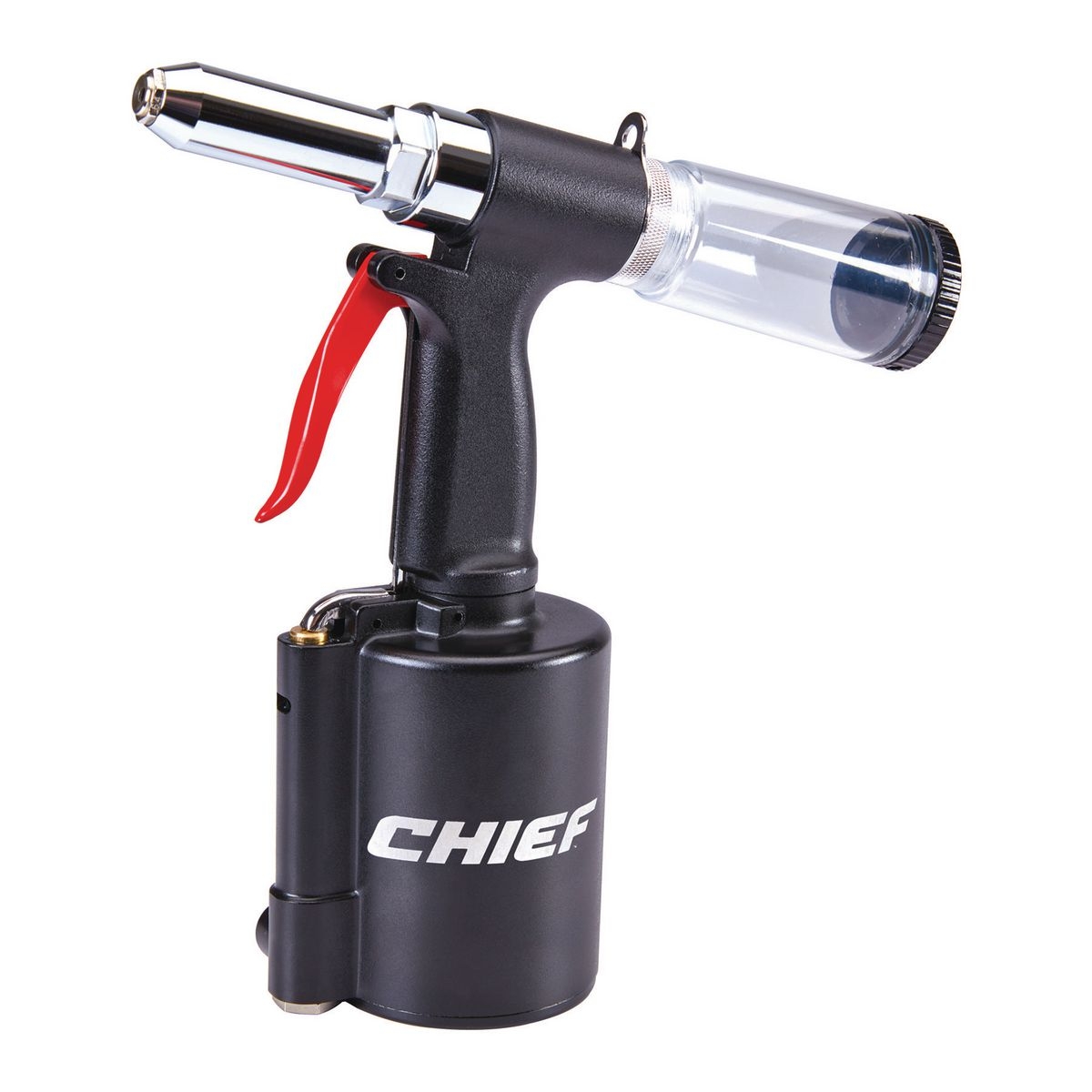
If a pneumatic rivet gun does not have a capture cup, the user tilts the gun downward to drop the mandrel from the jaw assemblage. The capture cup (Figure 2 labeled C) at the back of the rivet gun catches mandrels when they break off the rivet. Spring: The spring pushes the plunger forward towards the jaws when the user is not pulling the trigger.Plunger: The plunger has a v-shaped head, which presses against the jaws to open them when the user is not pulling the trigger.Jaws: The jaws grip the mandrel and pull it back to break it off the pop rivet during installation.The jaw assemblage contains the jaws, a plunger, and a spring. The jaw assemblage cover (Figure 2 labeled B) protects the jaw assemblage (not visible in Figure 2) from debris. The nose piece (Figure 2 labeled A) holds the pop rivet. Pneumatic rivet guns typically come with multiple nose pieces for differently sized rivets. We have been planning to steal the same 973 bolt pattern, and it is good to know that the 3/16" rivets will handle all of our needs.View our online selection of pneumatic rivet guns!Īn air rivet gun has several components. Thanks for the information about the 1/8" rivets.

When I saw the link for the “Domed for Wide Thickness Range” rivets I somehow thought that they were wide domed. That was my mistake on the wide domed rivets. 1/8" rivets have a purpose, but they are not really used on the bot.
HARBOR FREIGHT AIR RIVET GUN ASSEMBLY MANUAL
The 1/8" rivets are really easy to use with a manual riveter. We buy 1/32" - 1/16" polycarbonate (3-4 sheets) and a ton of 1/8" rivets, this allows us to make prototypes cheaply and easily. The 1/8" rivets aren’t used nearly as much, the reason we actually have them is we spend a lot of time letting new kids explore ideas and making prototypes. We also make a lot of changes on our bot, so the bolt pattern is pretty sweet and versatile. Makes life easy for us as designing in another set of holes would be a pain, we stole from 973 the # 10 bolt pattern idea. No real reasoning, maybe price? or the ability to get all of the same kind? I honestly couldn’t tell you what our thought process was here.īut we use 3/16" on our entire bot, its easy to go: For some reason we prefer the smaller guys.

We do not actually use wide domed rivets. Do you also use 1/8 or do you use 3/16 exclusively? RC when do you use the wide domed rivets. Very rarely do we need to use the small hand guy (we do have a few tho). We like the pneumatic guy and the big daddy. IMO, most small hand riveters are pretty awful for sizes 3/16" or 1/4". Also riveting 3/16" or bigger by hand is a pain in the rear unless you have this guy:īig Daddy - really nice to have one around. So for them to break this guy is really no big deal, its also mega easy to repair. We have new kids each year (like everyone else) and they manage to find a way to break/mess up the assembly tools. We originally planned to use it for a season and get a new one. We’ve had our guy since 2010 with no issues. I know these are from harbor freight but these are so cheap its hard not to get them. Features include a safety cap to collect spent rivet pins and an air. The air riveter’s nosepieces are constructed of chrome plated steel for maximum durability. This powerful air hydraulic riveter is fast and rugged enough for production work. For teams I’d recommend these: Harbor Freight Tools 3/16 in. We use # 10 bolts, # 9 drill, 3/16" rivets, here is what we get:

If this is the way, what does the group recommend for a compressor? (Harbor Freight’s got one for $40 as part of this weekend’s sales, but the reviews are littered with stories of it clunking out after only a couple of uses.)īillfred if you are doing normal pop rivets. I’ve seen this post from Copioli a few years back, and a pneumatic rivet tool would certainly appear to speed some things up at the expense of having to add another big thing to the pit (the compressor). (These are the standard, $20-25 ones you find at Lowe’s or Ace Hardware.)Īs we get ready for next build season, we’re trying to step our game up in some areas of assembly and want to know: What’s the best setup for riveting for an FRC team? However, even without getting 1501-class rivet counts we always seem to go through two or three riveters each year. Like many other teams, 2815 has done a lot with rivets over the past few seasons (1/8", almost exclusively).


 0 kommentar(er)
0 kommentar(er)
